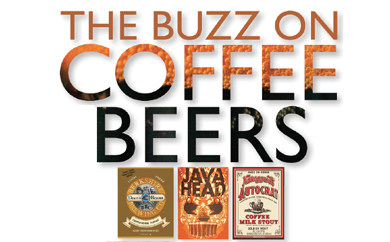THE BUZZ ON COFFEE BEERS
by Lew Bryson
ONE OF THE FIRST COFFEE BEERS I ever had was Berkshire Brewing’s COFFEEHOUSE PORTER, made with organic coffee from Dean’s Beans, in Orange, Massachusetts. The idea of a porter with coffee in it was irresistible, and the beer delivered on every bit of that. Coffeehouse is still on the market, a regular from Berkshire, but there are other coffee beers out there, more every day. Cambridge Brewing brewmaster Will Meyers has been making coffee stouts for a long time; “a million times,” he exaggerates. “When we first brewed coffee stouts,” he says, “we got fresh roasted coffee, ground it, and just threw it in the whirlpool. It was good for the early 199Os. But we noticed as we got to the end of the batch, it had a kind of ‘turned’ coffee oil character, we didn’t like it. Then we did hot-brewed coffee, and that worked better. But we finally graduated to a cold infusion: ground beans in sterile water, an 18 hour steep, blended into the fermented beer.” His latest coffee beer, Helper Monkey, was an American stout, flavored with beans from Fazenda, in Jamaica Plain – “A blend that we created: Mexican, Indonesian, South American, a medium-dark roast” – and cacao nibs from Taza, in Somerville.
Java Head, from Tröegs Brewing, was an overdue realization of the first business plan of brewery founders Chris and John Trogner: starting a coffee roasting business. “We were going to call it Magic Beans,” John remembers. Happily, the brewery idea won out. JAVA HEAD STOUT started with an oatmeal stout they were making. “We put coffee in it, and didn’t do it the right way. It was acrid, burnt, acidic, all the bad things of coffee. We learned. It starts with bean selection. We look for citrus qualities. We use a local roaster, use it within a day of roasting, and we do a very coarse grind. Too fine, and you get sludge that you will never get out of the bottle.” They also cold steep, then run the cold coffee into the hopback instead of hops. The cold coffee is sterilized by the boiling wort, then goes through the heat exchanger and into the fermenter. “You lose aromatics in fermentation, but that’s easy to fix. Just use more coffee!”
The popular Narragansett AUTOCRAT COFFEE MILK STOUT is done in a unique way; they add coffee extract syrup, supplied by Rhode Island favorite Autocrat itself, the stuff in Rhode Island’s state drink: coffee milk. Narragansett founder Mark Hellendrung notes that they start with a milk stout, with added lactose, non-fermentable milk sugar, for sweetness, then add the syrup. “We were able to find a great medley between the sweetness of our milk stout and the bitterness in Autocrat’s dark roast,” he says. It’s like coffee and cream in a 16-ounce can.
One fairly recent addition is Weyerbacher’s SUNDAY MORNING STOUT, which not only adds coffee to an imperial stout (their Tiny, brewed with a different yeast), they add it in a bourbon barrel. “We put coarse-grind coffee right in the barrel,” says brewmaster Chris Wilson. “We do three to four weeks in the barrel, dump it all into another fermenter, let it sit over the weekend to let the grounds to settle, and then centrifuge it. It’s essentially cold-steeping in the barrel.”
There’s another variation: vanilla. Ballast Point makes two coffee beers – VICTORY AT SEA, and CALM BEFORE THE STORM – both with added vanilla flavor. “Coffee was first added to our Sextant Oatmeal Stout with lackluster results,” recalls specialty brewer Colby Chandler. “We took it out, but soon after stumbled upon the recipe for Victory at Sea, an imperial porter with coffee and vanilla. Calm Before the Storm is our ‘summer’ version of Victory at Sea – a cream ale with coffee and vanilla. We find that the vanilla adds a nice balance to the roasty bitterness of the coffee.”
Boston Beer has made coffee beers before; their latest is in their Nitro series, the NITRO COFFEE STOUT. “We use Sumatra Mandheling to create rich chocolate and earthy flavors along with a bigger body and a mild acidity,” says brewer Jennifer Glanville. “We also brew with Indian Monsoon Malabar coffee beans [for] their characteristic smooth, mellow complexity with flavors of chocolate and distinct earthiness and a lower acidity.” Why nitrogenate? “The Sumatra Mandheling and Monsoon Malabar worked really well with the stout style,” she responds. “The creaminess of the beer creates a very decadent experience for the drinker.”
Finally, there’s Left Hand Brewing, which makes HARD WIRED NITRO, a nitro-charged seasonal, as well as pretty regular one-off releases of coffee beers; it’s a favorite flavor at the brewery. They also do a cold steep, but with finished beer instead of water. The concentrated ‘double brew’ is then blended back into the main batch . . . and then the same thing is done again four more times before the beer is packaged. Hard Wired indeed!
Different methods, different flavors, different philosophies: all about double brewing coffee and beer. But if you’re wondering if the beers will keep you up all night, not to worry. None of these beers have significant amounts of caffeine!

